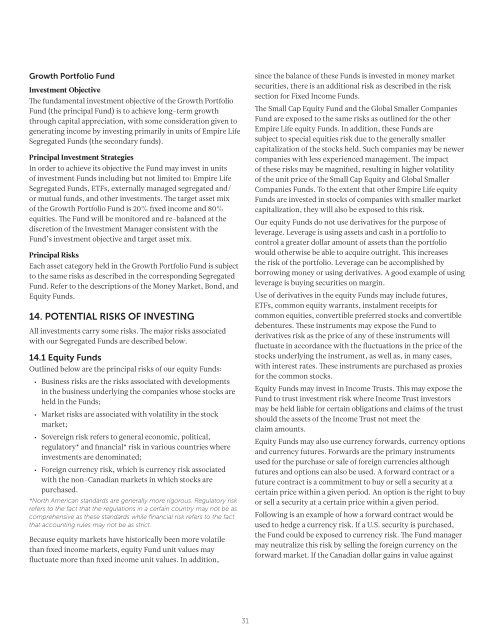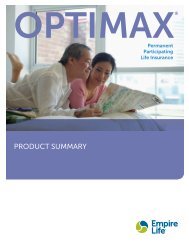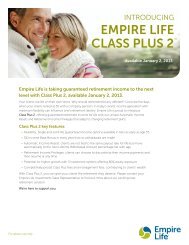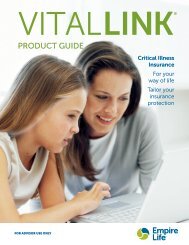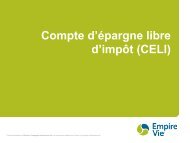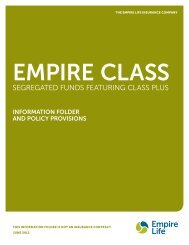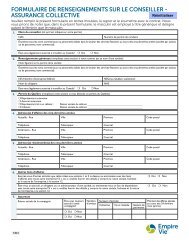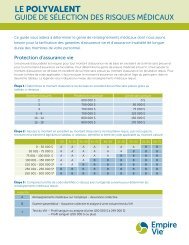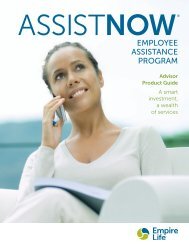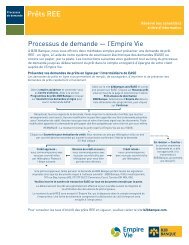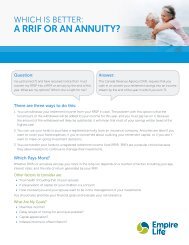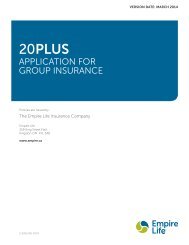Class Plus 2 Information Folder and Contract Provisions - Empire Life
Class Plus 2 Information Folder and Contract Provisions - Empire Life
Class Plus 2 Information Folder and Contract Provisions - Empire Life
- No tags were found...
Create successful ePaper yourself
Turn your PDF publications into a flip-book with our unique Google optimized e-Paper software.
Growth Portfolio FundInvestment ObjectiveThe fundamental investment objective of the Growth PortfolioFund (the principal Fund) is to achieve long-term growththrough capital appreciation, with some consideration given togenerating income by investing primarily in units of <strong>Empire</strong> <strong>Life</strong>Segregated Funds (the secondary funds).Principal Investment StrategiesIn order to achieve its objective the Fund may invest in unitsof investment Funds including but not limited to: <strong>Empire</strong> <strong>Life</strong>Segregated Funds, ETFs, externally managed segregated <strong>and</strong>/or mutual funds, <strong>and</strong> other investments. The target asset mixof the Growth Portfolio Fund is 20% fixed income <strong>and</strong> 80%equities. The Fund will be monitored <strong>and</strong> re-balanced at thediscretion of the Investment Manager consistent with theFund’s investment objective <strong>and</strong> target asset mix.Principal RisksEach asset category held in the Growth Portfolio Fund is subjectto the same risks as described in the corresponding SegregatedFund. Refer to the descriptions of the Money Market, Bond, <strong>and</strong>Equity Funds.14. POTENTIAL RISKS OF INVESTINGAll investments carry some risks. The major risks associatedwith our Segregated Funds are described below.14.1 Equity FundsOutlined below are the principal risks of our equity Funds:• Business risks are the risks associated with developmentsin the business underlying the companies whose stocks areheld in the Funds;• Market risks are associated with volatility in the stockmarket;• Sovereign risk refers to general economic, political,regulatory* <strong>and</strong> financial* risk in various countries whereinvestments are denominated;• Foreign currency risk, which is currency risk associatedwith the non-Canadian markets in which stocks arepurchased.*North American st<strong>and</strong>ards are generally more rigorous. Regulatory riskrefers to the fact that the regulations in a certain country may not be ascomprehensive as these st<strong>and</strong>ards while financial risk refers to the factthat accounting rules may not be as strict.Because equity markets have historically been more volatilethan fixed income markets, equity Fund unit values mayfluctuate more than fixed income unit values. In addition,since the balance of these Funds is invested in money marketsecurities, there is an additional risk as described in the risksection for Fixed Income Funds.The Small Cap Equity Fund <strong>and</strong> the Global Smaller CompaniesFund are exposed to the same risks as outlined for the other<strong>Empire</strong> <strong>Life</strong> equity Funds. In addition, these Funds aresubject to special equities risk due to the generally smallercapitalization of the stocks held. Such companies may be newercompanies with less experienced management. The impactof these risks may be magnified, resulting in higher volatilityof the unit price of the Small Cap Equity <strong>and</strong> Global SmallerCompanies Funds. To the extent that other <strong>Empire</strong> <strong>Life</strong> equityFunds are invested in stocks of companies with smaller marketcapitalization, they will also be exposed to this risk.Our equity Funds do not use derivatives for the purpose ofleverage. Leverage is using assets <strong>and</strong> cash in a portfolio tocontrol a greater dollar amount of assets than the portfoliowould otherwise be able to acquire outright. This increasesthe risk of the portfolio. Leverage can be accomplished byborrowing money or using derivatives. A good example of usingleverage is buying securities on margin.Use of derivatives in the equity Funds may include futures,ETFs, common equity warrants, instalment receipts forcommon equities, convertible preferred stocks <strong>and</strong> convertibledebentures. These instruments may expose the Fund toderivatives risk as the price of any of these instruments willfluctuate in accordance with the fluctuations in the price of thestocks underlying the instrument, as well as, in many cases,with interest rates. These instruments are purchased as proxiesfor the common stocks.Equity Funds may invest in Income Trusts. This may expose theFund to trust investment risk where Income Trust investorsmay be held liable for certain obligations <strong>and</strong> claims of the trustshould the assets of the Income Trust not meet theclaim amounts.Equity Funds may also use currency forwards, currency options<strong>and</strong> currency futures. Forwards are the primary instrumentsused for the purchase or sale of foreign currencies althoughfutures <strong>and</strong> options can also be used. A forward contract or afuture contract is a commitment to buy or sell a security at acertain price within a given period. An option is the right to buyor sell a security at a certain price within a given period.Following is an example of how a forward contract would beused to hedge a currency risk. If a U.S. security is purchased,the Fund could be exposed to currency risk. The Fund managermay neutralize this risk by selling the foreign currency on theforward market. If the Canadian dollar gains in value against31


